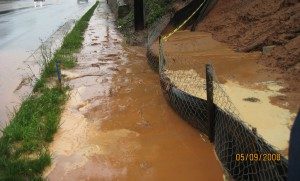Sedimentation occurs when particles from soil and other sources accumulate in streams and bodies of water, having been transported by rainwater as it drains from the land. Though it is a naturally occurring and beneficial process, the effects of sedimentation have been exacerbated by human activities and now pose a serious threat to water quality in the Catawba River Basin. These threats include eutrophication, algal blooms, and fish die-off events, while human activities most significantly contribute through runoff from developmental, agricultural, and industrial sites.

In North Carolina there are currently both legislation and organizations to address sedimentation. The North Carolina Sedimentation Control Commission (NCSCC) was established by and continues to enforce the regulations outlined within the Sedimentation Pollution Control Act of 1973. In the 2015-2016 fiscal year alone, the commission performed 10,234 Sedimentation and Stormwater inspections. Only 95 of these, however, resulted in report of violation, and a mere 8 of these instances were referred for enforcement. Considering these numbers, the fact that sedimentation continues to pose a threat to water quality suggests that current techniques and management of sediment filtration are inadequate. Additionally, there is evidence to suggest that developers fail to properly manage their sites for sedimentation more often than they are punished for it, suggesting that NCSCC inspection and enforcement procedures are not up to par.

In light of these observations, we first recommend that the NCSCC analyze current techniques and management of on-site sediment filtration. Techniques that are inefficient or ineffective should be prohibited. If there are too few appropriately effect techniques to accommodate the various topographies that developers will encounter statewide, then we recommend that the NCSCC develop new technique to be implemented immediately.
Second, we recommend that the NCSCC review its current inspection and enforcement procedures. Developers should be consistently held accountable for infractions, and it appears that the NCSCC has fallen short of this goal. We also recommend, if this practice is not already official procedure, that filtration systems be inspected on-site both on initial installation and at least one later point in development, ideally following rainfall.
Lastly, it is evident by residents’ direct and indirect contribution to sedimentation that the public needs to be educated. Though the Sedimentation Pollution Control Act of 1973 provided for an initial phase of education by the NCSCC (§ 113A-59), it is now time for them to repeat this practice with younger or unreached groups. In summation, we believe that these changes will have a positive impact on the management of sedimentation in the Catawba River Basin and in NC as a whole.
Sources
“Sediment and Suspended Sediment.” U.S. Geological Survey. 2 May 2016. Web.
“Sedimentation Control Commission.” North Carolina Department of Environmental Quality. n.d. Web.